Did you know that over 2 billion people use WhatsApp worldwide? With such a massive global user base, it's no wonder businesses are scrambling to leverage WhatsApp as a channel for customer communication and engagement. But with so many chatbot solutions on the market, how do you choose the best WhatsApp chatbot for your needs? In this comprehensive guide, we'll compare the top 5 WhatsApp chatbot tools and dive deep into their features, strengths, weaknesses, and ideal use cases.
Why Are Chatbot Interactions in WhatsApp Important for Businesses?
WhatsApp chatbots offer a convenient and accessible way for businesses to increase engagement and improve customer support operations. Here's why:
- 24/7 Availability: Chatbots can provide instant responses to customer inquiries, regardless of the time or day, ensuring that your business is always available to assist.
- Personalized Interactions: By leveraging customer data and preferences, chatbots can deliver personalized experiences, enhancing customer satisfaction and loyalty.
- Cost-Effective Solution: Automating repetitive tasks and handling high volumes of inquiries, chatbots can significantly reduce operational costs compared to traditional customer support methods.
- Increased Efficiency: Chatbots can handle multiple conversations simultaneously, reducing response times and improving overall efficiency in customer support.
- Scalability: As your business grows, chatbots can easily scale to accommodate increasing customer demands without the need for additional human resources.
By integrating chatbots into your WhatsApp strategy, you can unlock new opportunities for customer engagement, streamline support operations, and ultimately drive business growth.
How to Choose the Best WhatsApp Chatbot Platform?
Selecting the right WhatsApp chatbot platform is crucial for the success of your customer engagement strategy. Here are the key factors to consider when evaluating different solutions:
User Experience
A great chatbot platform should prioritize user experience, ensuring that interactions are:
- Intuitive: The chatbot interface should be easy to navigate and understand, even for first-time users.
- Conversational: Chatbots should engage in natural, human-like conversations to create a seamless user experience.
- Personalized: Leveraging customer data, chatbots should deliver tailored responses and recommendations.
Core Features and Functionalities
When comparing WhatsApp chatbot platforms, look for the following essential features:
- Visual Builder: A drag-and-drop interface that allows you to create chatbots without coding knowledge.
- NLP and ML: Natural Language Processing and Machine Learning capabilities for understanding user intent and providing accurate responses.
- Analytics and Reporting: Detailed insights into chatbot performance, user interactions, and areas for improvement.
Integration Options
To maximize the potential of your WhatsApp chatbot, consider platforms that offer seamless integrations with:
- CRM Systems: Sync customer data and interactions for a holistic view of your customer relationships.
- Third-Party Tools: Connect with popular tools like Zapier, and Google Sheets, for enhanced functionality.
- APIs: Flexibility to integrate with your existing systems and workflows through robust APIs.
By carefully evaluating these factors, you can select a WhatsApp chatbot platform that aligns with your business objectives, delivers exceptional user experiences, and drives meaningful customer engagement.
Advancements in Chatbot Technology
The world of chatbots has undergone significant transformations in recent years, thanks to the emergence of cutting-edge technologies. Let's explore how these advancements are reshaping the chatbot landscape:
LLMs and Their Impact on Chatbots
Large Language Models (LLMs) have revolutionized the way chatbots understand and generate human-like responses. Here's how LLMs are enhancing chatbot capabilities:
- Improved Natural Language Understanding: LLMs enable chatbots to better comprehend user intent, context, and sentiment, resulting in more accurate and relevant responses.
- Multilingual Support: With LLMs, chatbots can easily handle conversations in multiple languages, breaking down communication barriers and serving a global audience.
- Contextual Awareness: LLMs allow chatbots to maintain context throughout conversations, providing a more coherent and personalized user experience.
The Rise of No-Code Chatbot Builders
No-code chatbot builders have democratized chatbot development, making it accessible to businesses of all sizes. Here's how no-code platforms are changing the game:
- Empowering Non-Technical Users: With intuitive drag-and-drop interfaces, no-code builders enable anyone to create powerful chatbots without writing a single line of code.
- Rapid Deployment: No-code platforms significantly reduce the time and resources required to develop and launch chatbots, allowing businesses to quickly respond to customer needs.
- Cost-Effective Solution: By eliminating the need for specialized coding skills, no-code builders make chatbot development more affordable for businesses with limited budgets.
These advancements in chatbot technology are paving the way for more sophisticated, user-friendly, and accessible chatbot solutions, empowering businesses to deliver exceptional customer experiences on WhatsApp and beyond.
The Top 5 WhatsApp Chatbot Solutions Comparison
In this section, we'll take a deep dive into the top 5 WhatsApp chatbot solutions, comparing their features, pricing, strengths, weaknesses, and ideal use cases. Let's get started!
Typebot
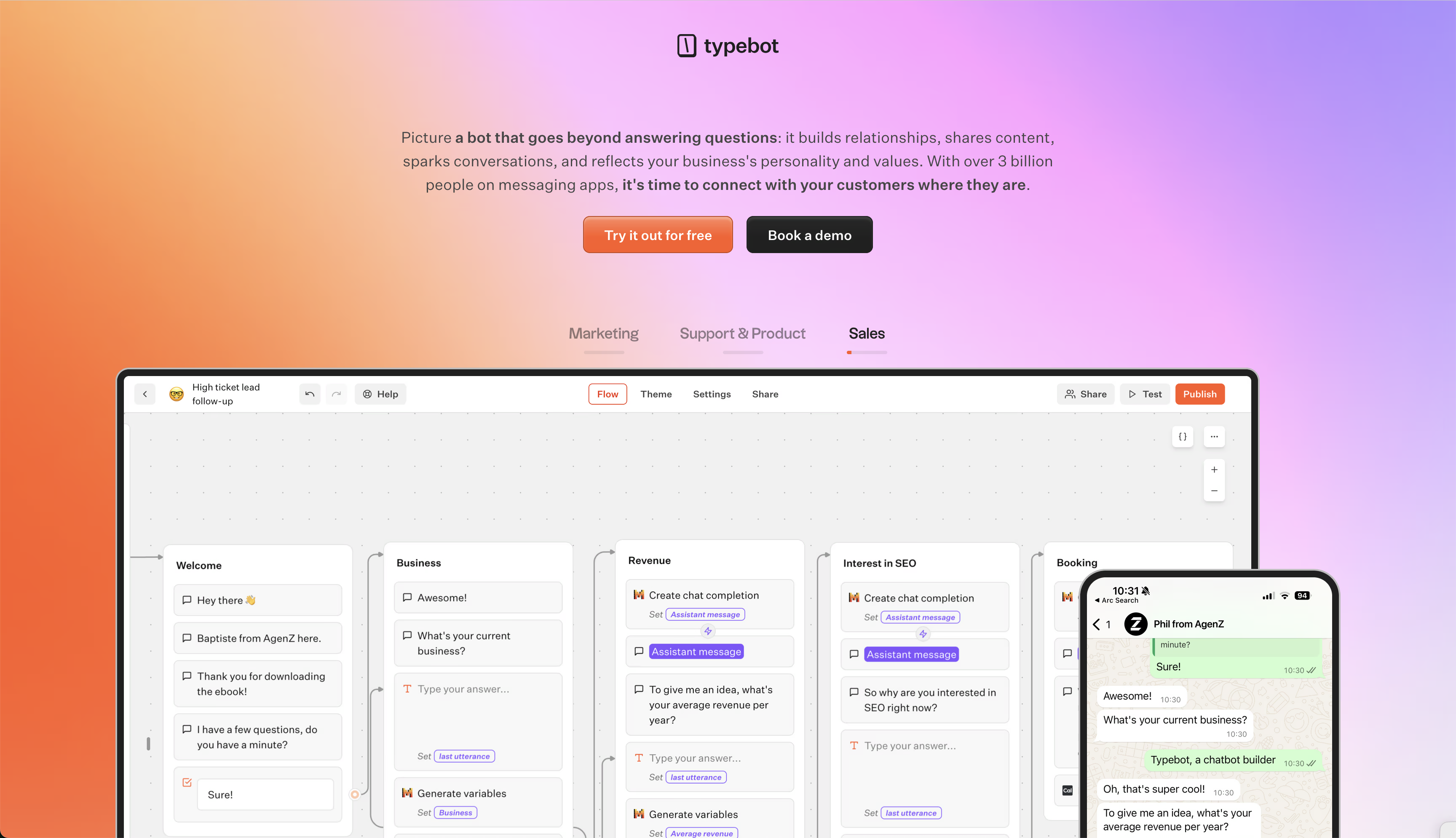
As the host of this article, it's only fitting that we start with Typebot. This powerful WhatsApp chatbot builder allows you to create advanced chatbots visually and embed them anywhere on your web or mobile apps.
With 34+ building blocks at your disposal, including text bubbles, images, videos, inputs (text, email, buttons, date pickers, payment via Stripe), conditional logic, URL redirections, scripting, and integrations with various tools like OpenAI, Google Sheets, Zapier, and more, the possibilities are endless.
Typebot comes with a generous free plan:
- Free Plan: With this plan, users can enjoy unlimited bots, 200 chats per month, and 2GB of storage. It also includes basic features that are perfect for those who are starting or are running small operations.
- Starter Plan ($39/month): This plan is available at $39 per month. It offers users up to 2,000 chats per month and 10GB of storage. It also includes 2 seats, making it ideal for small teams.
- Pro Plan ($99/month): For businesses with larger needs, the Pro Plan is available at $99 per month. It includes up to 10,000 chats per month, 10GB of storage, and 5 seats, providing more resources for larger teams and operations.
Typebot shines in its flexibility and customizability, allowing you to create unique chat experiences that match your brand identity. It's a great fit for solo business owners, startups, agencies, and large companies looking to build high-performing WhatsApp chatbots for lead generation, customer support, user onboarding, product presentations, registrations, quizzes, and surveys.
While Typebot's free plan is generous, it does lack some advanced features like priority support and in-depth analytics. And if you choose to self-host, you'll need to manage the infrastructure and maintenance yourself.
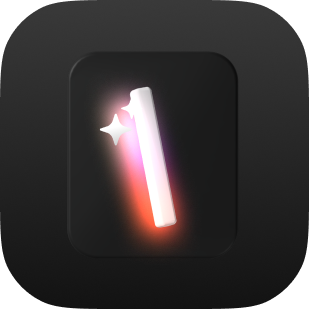
No trial. Generous free plan.
Respond.io
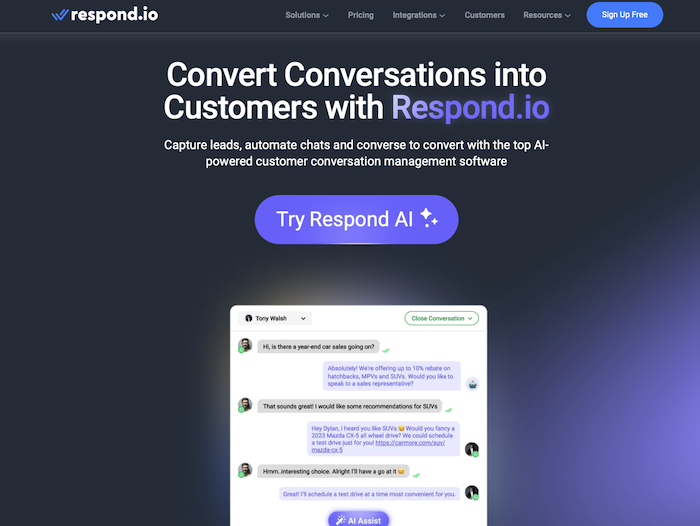
Respond.io is an AI-powered customer conversation management software designed for B2C companies looking to increase revenue by improving customer experiences through messaging.
It unifies multiple messaging channels like WhatsApp, Instagram DM, Facebook Messenger, email, SMS, and webchat into a single workspace. Key features include an omni-channel inbox, visual workflow builder, comprehensive reporting and analytics, and AI-powered tools like AI Agent, AI Prompts, and AI Assist.
Respond.io's pricing starts at $99/month for the Team plan (1,000 monthly active contacts, all messaging channels, 10 users) and $299/month for the Business plan (3,000 monthly active contacts, all messaging channels, 25 users).
While Respond.io is a versatile tool that helps streamline communication and customer service, its high price point and complex implementation process make it more suitable for large companies than small businesses. Some users have also noted inconsistencies in the services offered and room for improvement in customer support.
Tidio
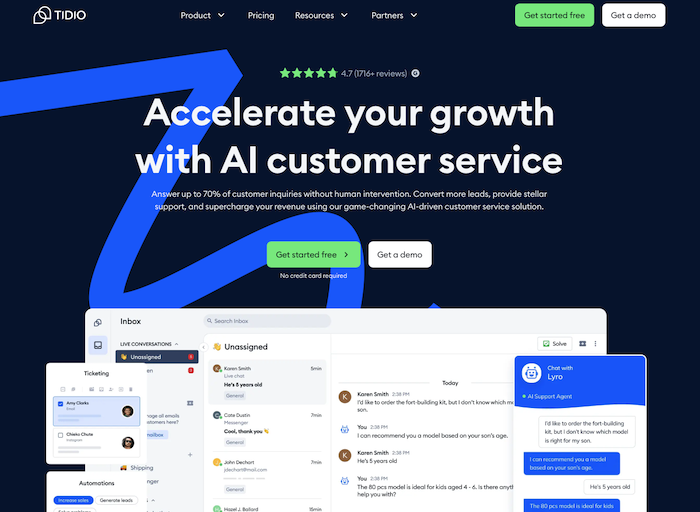
Tidio offers a free plan that includes basic live chat and chatbot features, as well as paid plans starting at $18/month for unlimited active chatbots and chatbot templates.
Its key features include AI-powered chatbots that can automate up to 47% of repetitive answers, a visual drag-and-drop chatbot builder (no coding required), multichannel communication management, detailed chatbot analytics, and reporting.
Tidio integrates with various ecommerce platforms, communication channels like Facebook Messenger and Instagram, and other tools like Google Analytics, Klaviyo, HubSpot, Zapier, and Zendesk.
One of Tidio's strengths is its ease of use and simple interface, enabling businesses to respond to tickets 3x faster than traditional tools. However, it can get expensive for higher volumes, lacks some advanced chatbot features compared to alternatives, and has limited integrations with social media channels like WhatsApp and Twitter.
Aivo
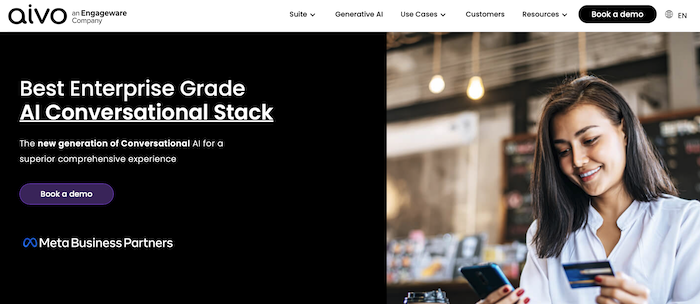
Aivo is a comprehensive conversational AI platform that enables automated customer experiences across multiple channels, including web chat, email, WhatsApp, Instagram, and Telegram.
Its key selling points include automated chatbots that can resolve up to 98% of customer inquiries without human escalation, conversational AI for personalized and fluid experiences, a no-code chatbot builder, and seamless integrations with tools like ChatGPT, Zendesk, Salesforce, Zapier, and more.
Aivo targets enterprise companies and has served major brands like Visa, GM, LG, and Sony. It claims to help reduce customer service costs in digital channels by over 30% and provide 24/7 customer support access.
However, Aivo lacks pricing transparency, requiring potential customers to contact their sales team for a demo and custom pricing. Some users have also reported limitations in the flexibility of automated responses and loss of formatting when importing content into the AgentBot.
Botpress
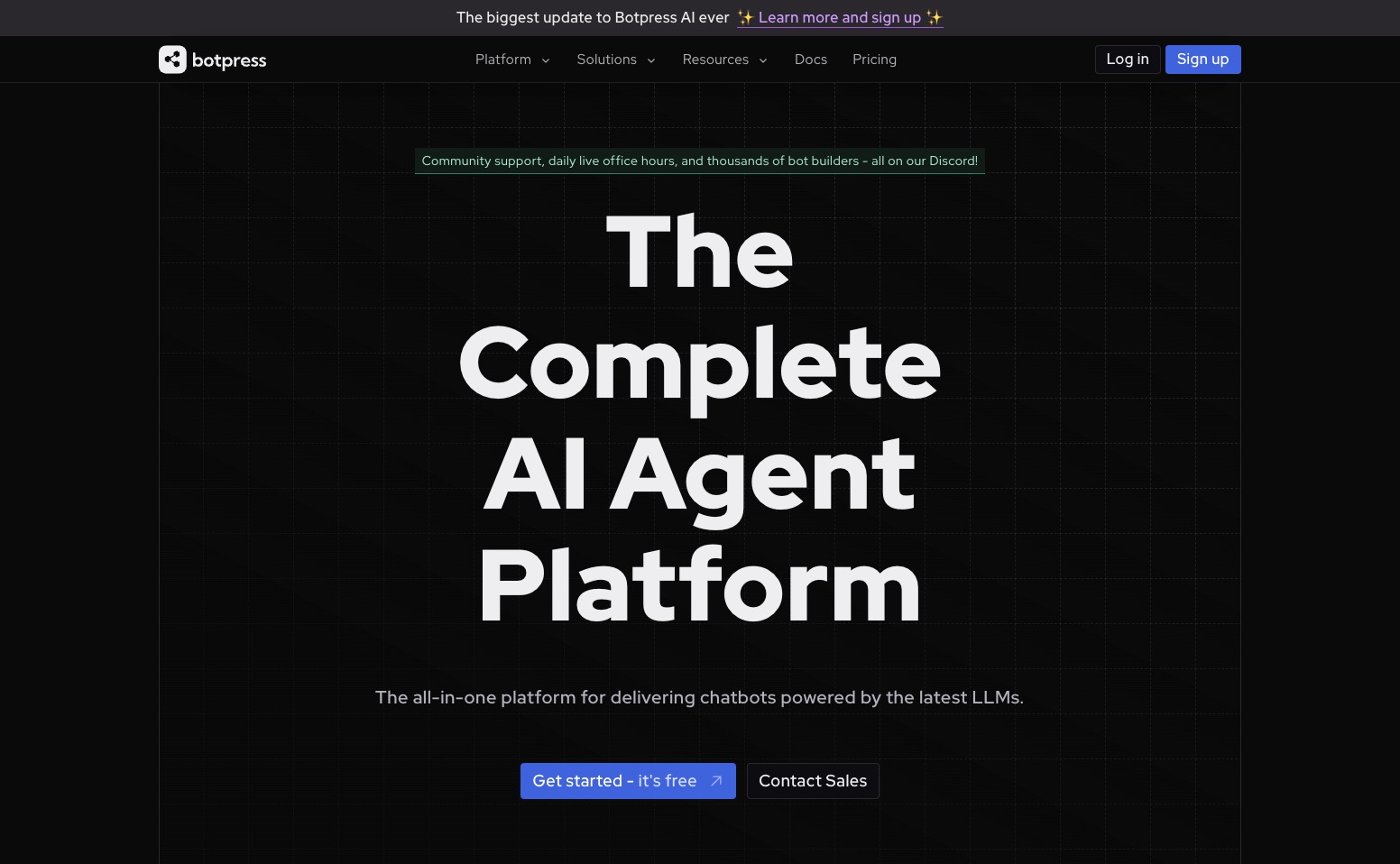
Last but not least, we have Botpress, an open-source chatbot building platform with built-in natural language processing (NLU) capabilities.
Botpress offers a free open-source version and a paid enterprise version with additional features like role-based access control and single sign-on (pricing available upon request).
Key features include a visual flow editor, content management system, human-in-the-loop for agent handoff, analytics and reporting, multilingual support, and the ability to integrate custom code and actions.
Botpress is highly customizable and extensible, with a strong NLU engine and an active developer community building plugins and add-ons. It's a great fit for enterprises, agencies, and startups needing to build sophisticated chatbots for automating customer support, lead generation, and other processes.
While Botpress is praised for its flexibility and NLU capabilities, it can be complex to configure and keep up with its fast-moving updates. The documentation sometimes lags behind the latest features, and the enterprise version lacks transparent pricing.
Check our selection of open source chatbots
Conclusion
WhatsApp chatbots have emerged as a game-changing solution for businesses looking to enhance their customer support and drive growth. By leveraging the power of conversational AI and the widespread popularity of WhatsApp, businesses can deliver personalized, efficient, and round-the-clock assistance to their customers.

No trial. Generous free plan.